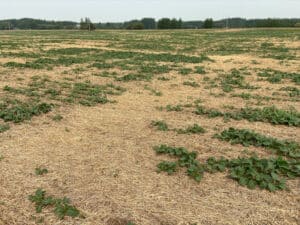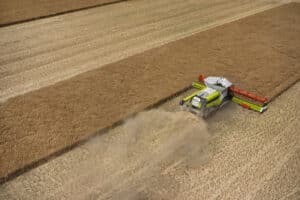Canola residue management that achieves a uniform spread will improve canola stand establishment. The fewer steps required to achieve uniform residue spread, the greater the profitability of canola. The combine alone can do the job.

The combine
The combine must be able to spread residue the full width of cut, creating a relatively even mat over the whole soil surface. When purchasing a new combine, put an emphasis on spreader and chopper performance. Ask the dealership for help on settings to match spread width to cut width. Consider after-market upgrades for older combines not up to the task.

Other combine adjustments to improve residue spread:
- Vanes or powered tailboard. Change the angle of vanes or, if possible on the combine model, speed up or slow down the disks on the power tailboard.
- Chopper knives. Sharpen or flip chopper knives and blades, and replace knives as needed.
- Chopper speed. Higher speeds may be necessary in heavy stubble or with wide headers. Chopper speed is crop dependent; adjustments are often necessary to suit the particular crop.
- Chaff spreader. Adjust as needed to get chaff spread as wide and thin as possible. For many combine models, choppers spread both straw and chaff.
- Combining conditions. Straw conditions will influence chopping and spreading. Tough straw can lead to a residue situation that is extremely difficult to remedy.
- Cut height. Taller stubble means less material through the combine, which leaves less to spread over the soil surface. Ideally, find a cut height that is tall enough to improve residue spreader performance but not too tall as to affect residue flow through the seeding tool.
Cut height and moisture
Phillip Harder is research director and hydrological scientist with Croptimistic Technology Inc. Harder has research showing that, in dry conditions, snow trapped in stubble and available to infiltrate in the spring doubles when you increase stubble height from 10cm (4”) to 20cm (8”), for example. He says benefits increase up to about 30cm (12”) stubble height.
This stubble also “drastically reduces” sublimation of the snowpack in the middle of winter, Harder says. Sublimation is the conversion of water from solid (snow) to vapour phase, which reduces the moisture available for infiltration in the spring. Harder says sublimation is most intense in windy and open areas where chinooks are common and no obstructions slow the wind. These areas often benefit most from the extra spring moisture.
Herb Cutforth, research scientist with Agriculture and Agri-Food Canada (AAFC) at semi-arid Swift Current, Saskatchewan, compared the effect of 30cm (12”), 15cm (6”) and cultivated stubble on the microclimate, water use and seed yield of canola. Tall stubble increased seed yield of canola by about 24 per cent and water use efficiency by about 19 per cent compared with stubble cultivated in the fall.
Cut height and crop establishment
Stubble height and residue distribution can be a factor in seeding tool performance, although the seeding tool will be a major determining factor. Blaine Metzger, former machinery researcher with the Government of Alberta, wrote in a Canola Digest article: “With the seeding tool, opener spacing, equipment height clearance, number of rows and opener design will all influence the residue clearance capability.”
The general rule is to cut stubble at a height equal to or less than the seeding tool’s row spacing. If row spacing is 30cm (12”) cut stubble at 30cm or less.
Aaron Glenn, research scientist with AAFC in Brandon, Manitoba, led a study at seven sites from 2011 to 2013 to measure how stubble height and surface residue influenced the establishment, disease level and yield of canola. Preceding spring wheat stubble was cut at 20cm, 50cm and full length (harvested with a stripper header). Results showed no consistent significant effects of standing stubble height on canola emergence, disease pressure or yield at any of the sites.
Harrowing and tillage
Heavy harrows can spread straw in the fall or early spring if combine performance was inadequate. When using harrows, watch the level of aggressiveness as harrows can cause soil erosion and disturbance, which will degrade the seedbed and dry it out. Heavy harrows also disturbs the standing stubble that catches snow and reduces soil erosion.
When it comes to residue management, Blaine Metzger says tillage is never as good as a well-set combine. “A cultivator will help break up piles and spread them out, but will not incorporate quickly and may require several passes. A discer will cut, break up and incorporate residue quicker than cultivation, but will not spread out piles as quickly and would likely require more than one pass,” Metzger wrote. Light harrowing, he adds, is not effective in heavy residue.
Systems
Residue management can vary depending on a farm system.
- Semi-arid regions. Farms in dry areas often want to keep standing stubble to trap snow and enhance spring soil moisture levels. Standing stubble also protects soil from wind and water erosion. Surface residue can keep soils cooler and reduce evaporation of surface soil moisture. Some farms in arid regions use stripper headers that leave all or most of the stubble standing. Their systems include direct seeding systems with accurate guidance to seed between stubble rows, often using a disc drill that leaves minimal soil disturbance.
- Moist regions. Farms with higher moisture through rainfall or irrigation will have more residue and may turn to harrowing or tillage to manage high volumes of residue. Farm systems may include plant-growth regulators to shorten cereal stubble, specialized tillage tools to limit the passes required to spread residue, and seeding tools with features to cut through or dig under residue.
Tillage or harrowing to incorporate fall-applied herbicide or tillage to deep-band fall fertilizer can also serve to spread residue, achieving two jobs at once.
